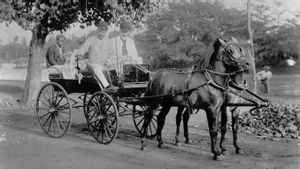JAKARTA - Koko shirt becomes one of the mandatory clothes used during Eid. Naturally, the clothes called coming from China are already identical to Muslim fashion. The question since when koko clothes become the identity of Muslim fashion?
The history of koko shirts there are various versions. First, according to historian JJ Rizal, quoted by Kompas Daily on September 4, 2010, koko shirt comes from tui-khim. At first koko clothes were the everyday clothes of Chinese men.
In the past, Chinese people combined tui-khim with pants soles or komprang. While the observer of Chinese culture, David Kwa, among the Betawi community, tui-khim is also worn and known as tikim shirt. He mentioned, the characteristics of tikim shirts are the same as koko shirts.
Looking back, in the early 20th century, since the founding of the Chinese Society in the Dutch East Indies, tui-khim shirts and kompreng pants began to be abandoned. Musababnya, Chinese men are allowed to wear Dutch clothing.
Therefore, according to Betawi Historian, Yahya Andi Saputra who was quoted by Merdeka said they do not wear the shirt anymore. Only some lower middle class citizens still wear the clothes.
"When the Chinese were free, they preferred to wear clothes like Europeans such as pantofel shoes and others. But there are still lower middle class people who wear that dress. Now the dress is chosen in white to be used as a Muslim dress," said Yahya.
While other versions there are also said the history of koko shirt comes from traditional Javanese clothes. His name is Surjan. This shirt is believed to be the "ancestor" of koko shirts in the archipelago.
Surjan is derived from the words "Su" and "ja" namely nglungsur wontern jaja (gliding through the chest), so that the front and back shapes have the same length. One of the characteristics of koko shirt is upright collared with long sleeves similar to a Javanese suit. It is also said that this dress was created by Sunan Kalijaga.
Surjan Jawa model was initially short-sleeved, but Sunan Kalijaga modified it to extend her arms into a 'piety shirt'. As the name implies, this shirt is usually used for religious events. However, the takwa shirt is called not adopted from tui-khim.
Other MEMORY
The English, Chinese, Japanese, Arabic, and French versions are automatically generated by the AI. So there may still be inaccuracies in translating, please always see Indonesian as our main language. (system supported by DigitalSiber.id)









